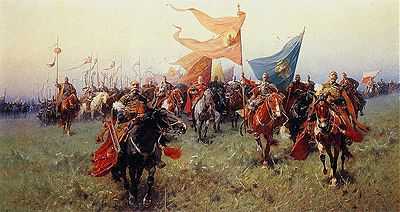| National Museum in Wrocław |
|---|

National Museum in Wrocław, central branch at pl. Powstańców Warszawy |
| Established |
1 January 1947 |
|---|
| Location |
Pl. Powstańców Warszawy 5
Wrocław, Poland |
|---|
| Type |
National museum |
|---|
| Director |
Mariusz Hermansdorfer [1] |
|---|
| Curator |
Bożena Guldan-Klamecka |
|---|
| Website |
www.mnwr.art.pl |
|---|
The National Museum in Wrocław (Polish: Muzeum Narodowe we Wrocławiu), established in 1947, is one of Poland's main branches of the National Museum system. It holds one of the largest collections of contemporary art in the country.[2]
The holdings of Wrocław Museum are closely connected with the history of border shifts in Central Europe following World War II. After the annexation of Eastern half of the Second Polish Republic by the Soviet Union, main parts of Poland's art collections were transferred from the cities incorporated into the USSR including Lwów and Kijów. Collections not returned included the Ossolineum holdings which became part of the Lviv National Museum.[3] The cultural heritage shipped in 1946 included Polish and European paintings from 17th to 19th centuries. The 1948 unveiling of the Wrocław Gallery of Polish Painting at a brand new location, composed of national treasures from already disappropriated museums, had a symbolic meaning in the lives of people subjected to mass expulsions from the Eastern Kresy. The Gallery was arranged to remind them, that they were again residing in Poland.[2]
Conclusion of World War II
Most historic buildings in Wrocław were destroyed or heavily damaged in World War II (see: the Siege of Breslau). The new Polish Department of Museums and Heritage Protection (Referat Muzeów i Ochrony Zabytków, RMOZ) was entrusted with the task of selecting a suitable placement for the newly arriving cultural artifacts. The relatively undamaged location was chosen on January 1, 1947 among the ruins of the old city center, at the former Silesian regency office built in 1883–1886.[2]
Although the location of National Museum and its collections were new in Wrocław, the actual tradition of art museums in the city were centuries old. Its predecessors included the Royal Museum of Art and Antiquity formed in 1815 (German: Königliches Museum für Kunst und Altertümer) and the Silesian Museum of Fine Arts created in 1880, as well as the Silesian Museum of Applied Arts formed in 1899. When Poland disappeared from the map of Europe at the end of the 18th century many artifacts produced by Polish artists and artisans were also displayed there.[2]
Permanent exhibits
Admission to gallery is free on Saturdays. Among the permanent exhibits set up on different floors of the Museum are four distinct departments divided by art-periods and historical epochs. The oldest is the "Silesian Art of the 12th to 16th century", featuring tombs of Silesian princes and most precious works of the Gothic art in Poland. The second is the "Silesian Art of the 16th to 19th century" with sculpture, painting and decorative arts from Silesian Renaissance to Romanticism. The next is the "Polish Art of the 17th to 19th century" with Polish Baroque portraits by Marceli Bacciarelli and Canaletto among others. And finally, the renown "Polish Art of the 20th century" collection with art of Tadeusz Makowski, Stanisław Ignacy Witkiewicz, Władysław Strzemiński, Henryk Stażewski, Alina Szapocznikow, Tadeusz Kantor, Tadeusz Makowski, Jerzy Nowosielski, Józef Szajna, Magdalena Abakanowicz and many prominent others. Month of September 2011 marked the opening of "New Gallery of Contemporary Art" in the Museum’s remodelled attic.[4]
| Selected paintings from the museum collections |
|---|
| Józef Chełmoński, Hunting (1882) |
|
Museum divisions
- Ethnographical Museum (at the Palace of Bishops)
- The Racławice Panorama Museum
- On loan: Museum of Silesian Piast Dynasty in Brzeg, and the City Museum (Wrocław Townhall)
See also
Notes and references
Coordinates: 51°06′39″N 17°02′51.4″E / 51.11083°N 17.047611°E / 51.11083; 17.047611

 Media related to National Museum in Wrocław at Wikimedia Commons
Media related to National Museum in Wrocław at Wikimedia Commons






